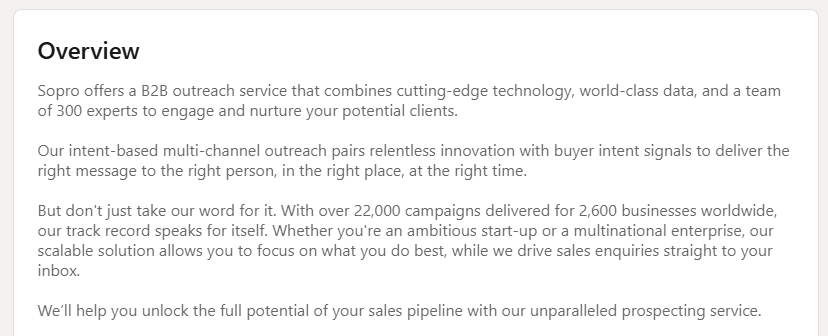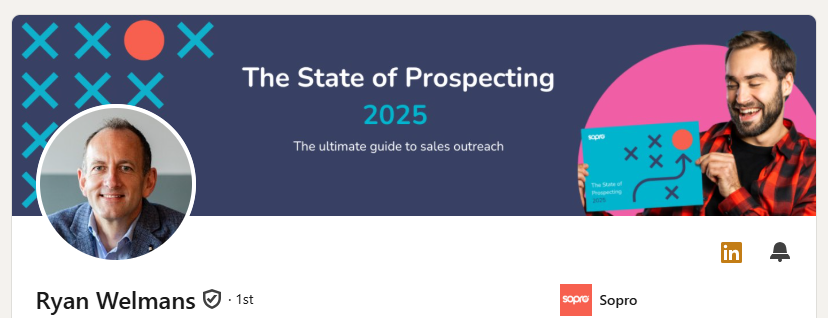How to grow your LinkedIn network for optimised B2B outreach

If you’re in the business of connecting with prospects via LinkedIn, you’ll need to ensure that your personal profile is up to standard. With our LinkedIn hacks, you can grow your network in no time.
One of the quickest and easiest ways to interact with prospects and bring them personalised updates is through LinkedIn—and we love to see it. That’s if you’re doing it right!
If you’re in the business of sales, then social selling should definitely be on your radar. Need a little refresher? We’ve got you.
Social selling is the practice of using social networking sites, such as LinkedIn, to connect and build relationships with prospects and leads who could benefit from your product or service. The intention is to drive sales and increase authority.
It’s a formidable tool, especially when B2B buyers have stamped LinkedIn as their second most popular form of outreach to be contacted on.
But with 44% of companies using LinkedIn lead generation, how do you stand out from the competition?

Optimise your company LinkedIn page
With more than one billion users, turn this platform into your B2B sales tool
Learn moreThat’s easy! Follow our LinkedIn hacks for optimised outreach and gain expert insight on how you grow your LinkedIn network.
Optimising your LinkedIn profile
Before we get into the nitty-gritty, it’s important to quickly review your profile and see what could be improved. After all, it’s the first thing that a prospect will take a look at when they’ve received a message from you.
Make sure you’re impressing them from the jump.
Crafting a compelling headline
Did you know? Your LinkedIn headline is 46% more important than any other aspect of your profile. It sets the stage for what’s to come, and prospects will look here to identify if it’s worth reading on.
This is prime real estate for showing off your creativity, but with a small word count, let’s make sure it’s snappy and shows off your business prowess.
You’ve got 220 characters to get your prospect engaged, so what’s the tactic?
Show them how your product or service can help with their goals or common pain points – stand out with your value proposition.
Here are two great examples:
Example one: (we might be the inspiration)
Helping you reach the right prospects at the right time with data-backed research and a team of experts in multi-channel outreach.
Example two:
Your go-to Automation expert. Having been in the business for 10 years, I’ve helped over 200 clients save £200,000 with tools suited to the needs of their sales teams.
And two more from Sopro and our CEO:
(don’t say we never treat you)
Sopro example:
B2B outreach service │ Helping you start new sales conversations with your ideal customers.
Sopro CEO, Ryan Welmans:

Cover how you’ll help your prospect. If you’re not sure what to say, consult your customer reviews and testimonials! Hopefully, this will give you a clear insight into what previous clients have been most pleased with in regard to your offering.
Writing an engaging summary
The next stage of growing your LinkedIn presence is by looking at your LinkedIn summary or “About”. You’ll be pleased to know that you have a little more wiggle room here—2600 characters!
Even though you have more space, it doesn’t mean you should use every last character. So, what do you need to include? Great question.
While social selling demands that you make every bit of content about your prospects, this is a moment for you to shine. Here are just a few tidbits to think about:
- Explain what you do, how you do it, and why you enjoy it. This would be a great opportunity to showcase the successful outcomes you have provided for your client or even the products and services that you offer.
- What are your key strengths, and how can this be backed by results or achievements throughout your career? Do you have some impressive stats? Don’t forget to include them.
- Avoid jargon – it’s off-putting and can lead to prospects clicking away sharpish. Be particularly careful of using language that is popular even within your own business. Getting someone to sense-check from outside of your place of work is always a good idea.
- Add relevant keywords to ensure that your profile ranks well and can be more visible within your industry with an audience you are trying to reach.
- Keep it concise. The preview only shows the first three lines, so you’ll want to draw the eye with information that will benefit those who are likely to work with you.
- Include a call to action and your contact information – make it exceedingly easy for people to get in touch with you.
- Avoid huge blocks of text—they look overwhelming. Keep it snappy, and don’t greet your profile visitors with a huge wall of text.
An example just for you:

Clearly highlight your experience and skills
An up to date LinkedIn profile is a great LinkedIn profile.
Ensure that your work experience is up to date throughout the years. Link to the actual business pages, ensuring that there are visible logos, and add succinct descriptions of what you did and achieved during your time there.
Doing this helps to make your profile look more trustworthy and can help with your overall credibility.
Keep it professional, headshot and all
No selfies or group holiday shots here, please! And absolutely no pixelated images.
Optimise your LinkedIn profile and make it look professional with a headshot and banner.
Here are your must-haves:
Profile picture:
- High res image
- 400×400 pixels
- No more than 8MB
- Your face should ideally take up 60% of the frame
Banner:
- High res image
- 1548×396 pixels
- No more than 8MB
- Very wide aspect ratio
When considering what to put for your banner image, consider whether it compliments your business, industry, location or professional qualifications. Here’s an example of our CEO flying the Sopro flag alongside a professional headshot:

Building a targeted connection strategy
It might be tempting to add every Tom, Dick and Harry to your LinkedIn account, but when trying to build a reputable profile in the world of sales, it might be a fruitless tactic that you’ll want to avoid.
The platform has 61 million senior-level influencers and 65 million decision-makers. This is certainly the place to be, but since you’re not looking for one million connections, let’s build a targeted connection strategy to focus exclusively on your target market.
We’re aiming for quality or quantity.
To start, you’ll want to focus on the following:
- Employees from your current position and previous roles
- Members from communities and groups that correlate with your current industry
- Clients that you have worked with, as well as those that you are currently working with
- People you know who are in line with your target market
- And most importantly, prospects that you are engaging with
From there, you can build on your connections further by digging deeper.
If you’re actively posting (you should be), take a look at who is engaging with your posts. If they sit within your target market, there’s certainly no harm in sending out a connection request. After all, they’re showing an active interest in what you have to say. We’ll dig a little deeper into this momentarily.
Identifying your target audience
Utilise LinkedIn’s search features
To optimise your LinkedIn for B2B sales, leverage LinkedIn’s search features to identify and connect with potential clients and industry leaders. It’s a valuable tool – use it.
Use filters to target specific industries, job titles, and locations. And be sure to regularly check “Suggested Connections” for relevant contacts.
Personalise your connection requests
Sending a connection request without a message might indicate a lack of attention and, furthermore, might be ignored, as the recipient may not understand why you’re attempting to connect.
But fair warning – you’ve only got 300 characters to send along with your request.
To elevate your connection outreach, be sure to demonstrate the following when sending that initial message:
Be professional
Not your average social media platform! This is a space to connect with business people, so as much as it’s important to avoid jargon, try not to be too informal.
Show your relevance for connecting
Help the recipient understand why you want to connect with them and why it will be mutually beneficial.
Make it personal
Show that you’ve done your research. If they’ve recently been promoted, congratulate them! If their company has recently produced a report, reference it.
Adding a human touch shows that you’re not just spamming out requests and you’re doing so with purpose.
Use buyer intent to connect
97% of B2B marketers already use LinkedIn as part of their lead generation strategy, so how do you cut above the rest? By harnessing the power of buyer intent, of course!
Using buyer intent on LinkedIn involves identifying potential clients based on their behaviour and engagement, such as viewing your profile, interacting with your posts, or showing interest in similar products.
You can start by monitoring who engages with your content and browsing the profiles of those in decision-making roles.
You can also use LinkedIn Sales Navigator to apply filters that match your ideal customer profile, focusing on recent activities indicating purchase readiness.
Sending targeted connection requests based on buyer intent is a valuable tactic because it increases the likelihood of acceptance and engagement. It demonstrates that you’ve done your research, showing prospects that you understand their needs and can offer relevant solutions.
This strategic approach enhances connection rates and paves the way for more meaningful conversations, ultimately boosting your sales opportunities. That’s what we call a LinkedIn hack!
Thought leadership tactics
Establishing yourself as a thought leader is another valuable way to build your profile and strengthen your reach. And it works.
88% of decision-makers agreed that thought leadership enhanced their perception of an organisation, and 48% said that this style of content could influence their buying decisions. Food for thought.
Share valuable content to position you as a thought leader
Content is at the heart of thought leadership.
Sharing insights, industry trends, and expert opinions can establish your authority and credibility in your industry and garner attention from a wide range of users.
This type of content fosters trust and engagement, encouraging others to connect with you. As your network grows, so does your reach, amplifying your influence and creating more opportunities for business development.
Regular, high-quality content keeps you top of mind, making initiating conversations and building relationships easier. This is crucial for successful B2B sales.
Examples of content that you can work towards include:
- How-to guides and top tips
- Opinion pieces
- Industry trends and insights
- Case studies and success stories
- Personal anecdotes
We might just have another great example for you… 👇
Participate in LinkedIn groups
Do your research, and you’ll find your target market following certain “top voices” or groups related to your respective industries. Don’t pass up on your chances of joining and participating!
Doing so will increase your reach and once again establish a level of trust and authority.
Engage with other users’ content
Being a thought leader is about presenting yourself as the expert in your field, but leaders are also there to participate and encourage. This is why you should also allot time to engage with other posts.
It’s all about being part of the conversation and building a community—this is a great way to get involved. It also presents you as an approachable personality, especially if you’re in an industry that can often be perceived as intimidating, particularly where the topics of conversation are complex.
Leveraging LinkedIn features for growth
Top tip: Use the tools that are available to you. There are plenty available on LinkedIn, from diving deep into the analytics to refine your practices to going all the way with InMail. Let’s have a look at some of them.
LinkedIn analytics
As with any form of content and outreach strategy, the numbers can provide valuable insights on optimising your performance.
Increasing your presence on LinkedIn is a tactical move, especially as you get access to LinkedIn Analytics. It’s a vital tool for growing connections in the world of B2B sales as it provides insights into your audience and content performance.
The data available at your fingertips includes profile views, post impressions, engagement metrics (likes, comments, shares), and follower demographics (location, job titles, industries). This information helps you understand who is interested in your content and identify potential leads.
By analysing which posts resonate most with your audience, you can tailor your content strategy to better meet their interests and needs.
Monitoring profile views reveals who is checking your profile, allowing targeted outreach to engaged prospects.
Additionally, understanding follower demographics helps refine your search for new connections, ensuring you focus on relevant industries and roles.
Using LinkedIn Analytics to guide your efforts enhances your ability to connect with key decision-makers and will drive more effective and targeted B2B sales outreach. Trust the data!
Once you’ve nailed that, you can expand your knowledge of metrics and KPIs, which are perfect for data-driven B2B sales growth… There’s a whole world of numbers out there!

How to use B2B metrics for data-driven growth
Harness analytics, goals, and B2B sales KPIs to drive data-driven approach to sales optimisation and growth
Get the guideExperimenting with LinkedIn Ads
If you haven’t quite caught our drift yet, expanding your LinkedIn network can be a game-changer for professional growth, and experimenting with LinkedIn ads is a strategic way to achieve this.
Let’s take a closer look at how to get more connections on LinkedIn by leveraging targeted ad campaigns. Whether you’re aiming to enhance your personal brand, connect with industry peers, or generate leads, mastering LinkedIn ads can significantly boost your network growth.
Take advantage of LinkedIn Premium features
LinkedIn Premium offers features that are particularly valuable for B2B sales success.
With these extra features, you’ll get access to advanced search filters, enabling you to find and connect with key decision-makers in your industry. With an average of four stakeholders involved in the decision-making process, it gives you more scope and visibility.
InMail credits allow you to message potential leads directly without needing a prior connection. They are a must for your B2B sales outreach strategies.
In addition, you have Premium insights that provide detailed analytics on profile views and company data, helping you tailor your outreach. You can also see who viewed your profile, giving you an opportunity to engage with interested prospects.
These tools collectively enhance your ability to grow connections, build relationships, and drive B2B sales.
InMail for B2B outreach
Fans of using InMail as part of our prospecting service, we want to explain why it’s a must when expanding your LinkedIn network and making it routine in your B2B sales outreach.
InMail is a powerful feature of LinkedIn Premium that allows you to send direct messages to any LinkedIn member, even if you’re not connected. This is invaluable for growing your connections, as it bypasses the need for mutual connections or introductions.
By using InMail, you ensure your messages land in the recipient’s inbox, increasing the likelihood of engagement. It’s particularly useful for reaching out to decision-makers, potential clients, or industry influencers.
By crafting personalised messages that resonate, you can initiate meaningful conversations, establish new connections, and expand your professional network. This makes InMail an essential tool for effective LinkedIn outreach.

LinkedIn lead generation best practice
From setting yourself up for success to sending an InMail that strikes the right chord, we’ve got you covered
DiscvermoreNew feature alert
There’s a new feature on the scene!
Companies can now create sponsored content from employee posts, offering a fresh way to amplify employee voices. This feature enables businesses to select organic posts shared by employees and turn them into sponsored content. Linking up with your marketing department to make this happen might be a savvy move.
By doing so, companies can leverage their workforce’s genuine perspectives and experiences to enhance their brand’s credibility and reach a wider audience.
This approach boosts engagement and helps build trust, as employees’ content is often perceived as more authentic and relatable.
For B2B sales, potential clients could be more likely to engage with and respond to these genuine narratives, leading to stronger connections and increased sales opportunities. This feature empowers businesses to harness the power of employee advocacy, making for an elevated LinkedIn marketing strategy that is much more effective and authentic.
Maintaining and nurturing your network
It goes without saying that growing your LinkedIn is an ongoing process. Maintaining and nurturing your LinkedIn network is crucial for B2B sales success.

The art of B2B lead nurturing
Elevate your sales and marketing efforts to develop effective B2B lead nurturing strategies
Learn moreRegular engagement with your connections through thoughtful comments, likes, and shares on their posts keeps you visible and strengthens relationships.
Personalised follow-ups and consistent communication demonstrate genuine interest and build trust over time. Sharing valuable content, such as industry insights or helpful articles, positions you as a knowledgeable resource, encouraging connections to engage with you more frequently.
Additionally, be sure to regularly update your profile with new skills, endorsements, and recommendations to keep it current and appealing.
A well-maintained network and optimised profile together create a robust foundation for successful B2B sales, as nurturing relationships is key to converting connections into clients.
Consistency and authenticity are the keys to network growth
Growing your LinkedIn network for optimised B2B outreach is always an ongoing and layered process that hinges on maintaining a consistent and authentic presence.
Regularly updating your profile and engaging with your connections can easily position yourself as a credible and valuable contact within your industry.
Remember, quality trumps quantity—focus on building meaningful relationships that can lead to long-term business opportunities. Authentic interactions and a well-curated profile will help you stand out from the competition and foster trust and reliability, essential components for sustained network growth and B2B sales success. Keep experimenting, stay genuine, and watch your LinkedIn network flourish.
Want to integrate LinkedIn outreach into your sales strategy seamlessly? It’s our forte. Find out how our lead generation service can help you sell more.







Share